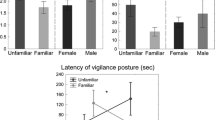Abstract
In order to study the mechanism involved in the seasonal territoriality of breeding bank voles, the social behavior and scent marking of paired females were observed throughout a reproductive cycle. Initially unfamiliar females were kept in large laboratory pens provided with individual burrows. After a brief period of hostility, females behaved in a friendly manner towards each other, sharing the same nest even in the presence of a male and until the middle of pregnancy. They scarcely marked with urine. Continuous olfactory assessment appeared to play an important role in maintaining the friendly interactions. In late pregnant and lactating females, on the contrary, the odor of a familiar female triggered aggressiveness and scent marking with urine and probably with flank glands. These reactions may be interpreted as spacing behavior. Moreover, the interaction between females may inhibit reproduction in one of them. These results are discussed in relation with the available ecological data.
Similar content being viewed by others
References
Albov, S.A., Karulin, B.E., andKhlyap, L.A. 1979. The utilization of resting places by the common redbacked vole (Clethrionomys glareolus) by the data of radioactive marking.Zool. Zh. 58(2):241–247.
Batzli, G.O., Getz, L.L., andHurley, S.S. 1977. Suppression of growth and reproduction of microtine rodents by social factors.J. Mammal. 58(4):583–591.
Bondrup-Nielsen, S., andKarlsson, F. 1985. Movements and spatial patterns in populations ofClethrionomys species. A review.Ann. Zool. Fenn. 22:385–392.
Brown, R.E. 1987. The rodents II: Suborder Myomorpha, pp. 345–457,in R.E. Brown and D.W. MacDonald (eds.). Social Odors in Mammals. Clarendon Press, Oxford.
Bujalska, G. 1970. Reproduction stabilizing elements in an island population ofClethrionomys glareolus (Schreber, 1780).Acta Theriol. 15(25):381–412.
Bujalska, G. 1973. The role of spacing behavior among females in the regulation of the reproduction in the bank vole.J. Reprod. Fertil. 19:463–472.
Bujalska, G. 1985. Regulation of female maturation inClethrionomys species, with special reference to an island population ofC. glareolus.Ann. Zool. Fenn. 22:331–342.
Carter, C.S., andGetz, L.L. 1985. Social and hormonal determinants of reproductive patterns in the prairie vole, pp. 18–36,in R.J. Gilles and J. Balthazart (eds.). Neurobiology. Springer-Verlag, Berlin.
Christiansen, E., andDøving, K.B. 1976. Observations of the mating behavior of the bank vole,Clethrionomys glareolus.Behav. Biol. 17:263–266.
Clarke, J.R. 1956. The aggressive behaviour of the vole.Behavior 9:1–23.
Clarke, J.R., Clulow, F.V., andGrieg, F. 1970. Ovulation in the bank vole,Clethrionomys glareolus.J. Reprod. Fertil. 23:531.
Coleman, G.J., andColeman, S.C. 1986. Amstat, available from S.C. Coleman Ltd., 33 Leicester Road, Ashby-De-La-Zouch, Leicestershire LE6 5DA, U.K.
Desjardins, C., Maruniak, J.A., andBronson, F.H. 1973. Social rank in house mice: Differentiation revealed by ultraviolet visualization of urinary marking patterns.Science 182(4115):939–941.
Escherich, P.C. 1981. Social biology of the bushy-tailed woodrat,Neotoma cinera.Univ. Calif. Publ. Zool. 110:1–126.
Gebczynski, M. 1969. Social regulation of body temperature in the bank vole.Acta Theoriol. 14:427–440.
Gerling, S., andYahr, P. 1982. Maternal and parental pheromones in gerbils.Physiol. Behav. 10:667–673.
Getz, L.L., Dluzen, D., andMcDermott, J.L. 1983. Suppression of reproductive maturation in male-stimulated virgin femaleMicrotus by a female urinary chemosignal.Behav. Process 8:59–64.
Gosling, L.M. 1982. A reassessment of the function of scent marking in territories.Z. Tierpsychol. 60:89–118.
Hoffmeyer, I. 1982. Responses of female bank voles (Clethrionomys glareolus) to dominant vs. subordinate conspecific males and to urine odors from dominant vs subordinate males.Behav. Neur. Biol. 36:178–188.
Johst, V. 1967. Vergleichende Untersuchung des agonistischen Verhaltens einiger Arten vonClethrionomys.Z. Tierpsychol. 24:558–579.
Kawata, M. 1987. Pregnancy failure and suppression by female-female interaction in enclosed populations of the red-backed vole,Clethrionomys rufocanus bedfordiae.Behav. Ecol. Sociobiol. 20:89–97.
Mihok, S. 1976. Behaviour of subartic red-backed voles (Clethrionomys gapperi athabascae).Can. J. Zool. 54(11):1932–1945.
Mironov, A.D. 1990. Spatial and temporal organization of populations of the bank vole,Clethrionomys glareolus, pp. 181–192,in R.H. Tamarin, R.S. Ostfeld, S.R. Pugh, and G. Bujalska (eds.). Social Systems and Population Cycles in Voles. Advanced in Life Sciences. Birkhäuser Verlag, Basel.
Ostermeyer, M.C. 1983. Maternal aggression, pp. 151–179,in R.W. Elwood (ed.). Parental Behaviour of Rodents. John Wiley and Sons, Chichester.
Perrin, M.R. 1981. Seasonal changes in agonistic behavior ofClethrionomys gapperi in southeastern Manitoba and its possible relation to population regulation.Am. Midl. Nat. 106(1):102–110.
Rasmont, R., andRozenfeld, F. 1987. Artificial burrows and modular observation pens for voles and other small rodents.Ann. Soc. R. Zool. Belg. 117(1):77–83.
Rozenfeld, F.M., andRasmont, R. 1987. Urine marking in bank voles (Clethrionomys glareolus Schreber, 1780, Microtidae, Rodentia).Ann. Soc. R. Zool. Belg. 117(2):237–245.
Rozenfeld, F.M., andRasmont, R. 1991. Odour cue recognition by dominant male bank voles,Clethrionomys glareolus.Anim. Behav. 41:839–850.
Rozenfeld, F.M., Le Boulangé, E., andRasmont, R. 1987. Urine marking by male bank voles (Clethrionomys glareolus Schreber, 1780; Microtidae, Rodentia) in relation to their social rank.Can. J. Zool. 65:2594–2601.
Siegel, S., andCastellan, N.J. Jr. 1988. Nonparametric Statistics. McGraw-Hill, New York.
Viitala, J., andHoffmeyer, I. 1985. Social organization inClethrionomys compared withMicrotus andApodemus: Social odors, chemistry and biological effects.Ann. Zool. Fenn. 22:359–371.
Wallace, P., Owen, K., andThiessen, D. 1973. The control and function of maternal scent marking in the Mongolian gerbil.Physiol. Behav. 10:463–466.
Westlin, L.M., andGustafsson, T.O. 1984. Influence of age and artificial vaginal stimulation on fertility in female bank voles (Clethrionomys glareolus).J. Reprod. Fertil. 71:103–106.
Westlin, L.M., andNyholm, E. 1982. Sterile mating initiate the breeding season in the bank vole,Clethrionomys glareolus. A field and laboratory study.Can. J. Zool. 60:387–391.
Wiger, R. 1982. Roles of self regulatory mechanisms in cyclic populations ofClethrionomys with special reference toC. glareolus: A hypothesis.Oikos 38:60–71.
Yahr, P. 1976. Effect of hormones and lactation on gerbils that seldom scent mark spontaneously.Physiol. Behav. 16:395–399.
Ylönen, H., andViitala, J. 1985. Social overwintering and food distribution in the bank voleClethrionomys glareolus.Holarct. Ecol. 14:131–137.
Author information
Authors and Affiliations
Rights and permissions
About this article
Cite this article
Rozenfeld, F.M., Denoël, A. Chemical signals involved in spacing behavior of breeding female bank voles (Clethrionomys glareolus Schreber 1780, Microtidae, Rodentia). J Chem Ecol 20, 803–813 (1994). https://doi.org/10.1007/BF02059614
Received:
Accepted:
Issue Date:
DOI: https://doi.org/10.1007/BF02059614




